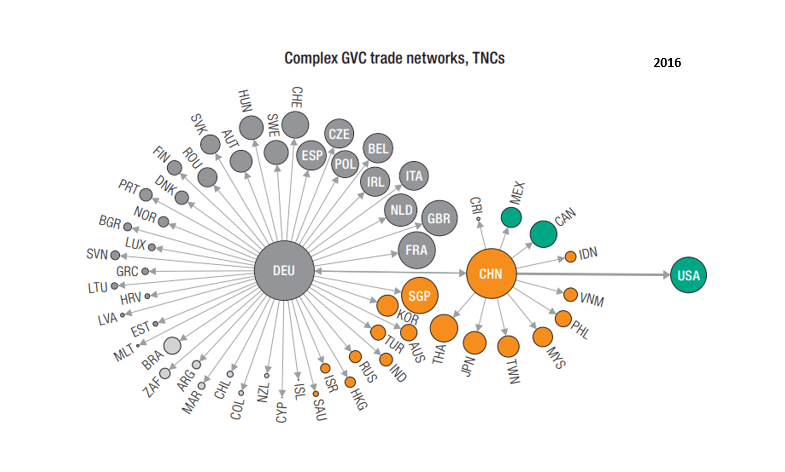Global Value Chains (GVCs) have China, the United States and Germany as their predominant centers, according to an analysis by the United Nations Conference on Trade and Development (UNCTAD).
To begin with, GVCs involving both domestically owned companies and transnational corporations (TNCs) in the manufacturing sector can be divided into three sub-networks: traditional trade, simple GVC trade and complex GVC trade.
From the supply side, between 2005 and 2016, value chains involving domestically owned firms from around the world increasingly developed in three regions centered on China, Germany and the United States, through both traditional trade and simple GVC trade.
According to UNCTAD, there appeared to be a pattern of dual centers in Germany and China through complex GVC trade.
At the national level, relatively rapid changes in network topology are observed.
First, China took over Japan‘s position and its share of manufacturing GVC value-added creation began to overtake that of Germany.
Global Value Chains
UNCTAD sees China as more likely to become a global hub with more surrounding countries, especially through simple and complex GVC trade.
This is largely in line with recent literature on China’s successful domestic industrial upgrading.
That is, China is not only the world’s largest supplier of final goods, but also supplies relatively more high-tech intermediate goods to serve its home countries directly through simple GVC trade and indirectly through complex GVC trade.
Second, the United States maintained its position as a regional hub for value-added supply, mainly for members of the Mexico-United States-Canada Agreement (USMCA), but its presence declined relatively, especially in complex GVC networks, in terms of the number of surrounding countries.
Nevertheless, the United States has become more interdependent with China. This is due, on the one hand, to the hollowing out of US low-tech manufacturing industries (offshored to low-tech and low-wage countries) and, on the other hand, to the upgrading and specialization of US high-tech manufacturing industries.
Third, Germany’s position as a regional center in Europe has remained relatively stable over time, while the Germany-US connection has been largely replaced by the Germany-China connection.

